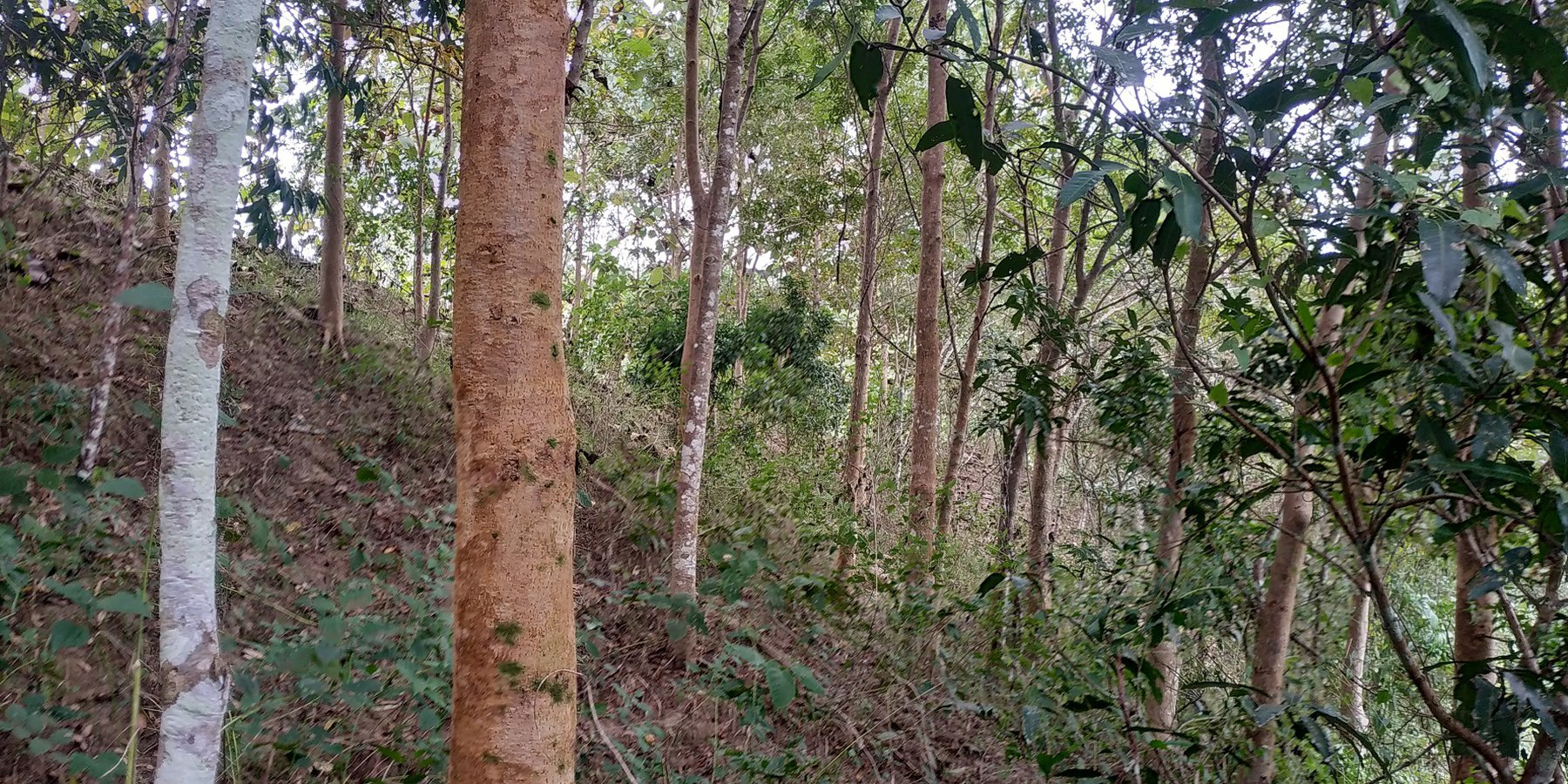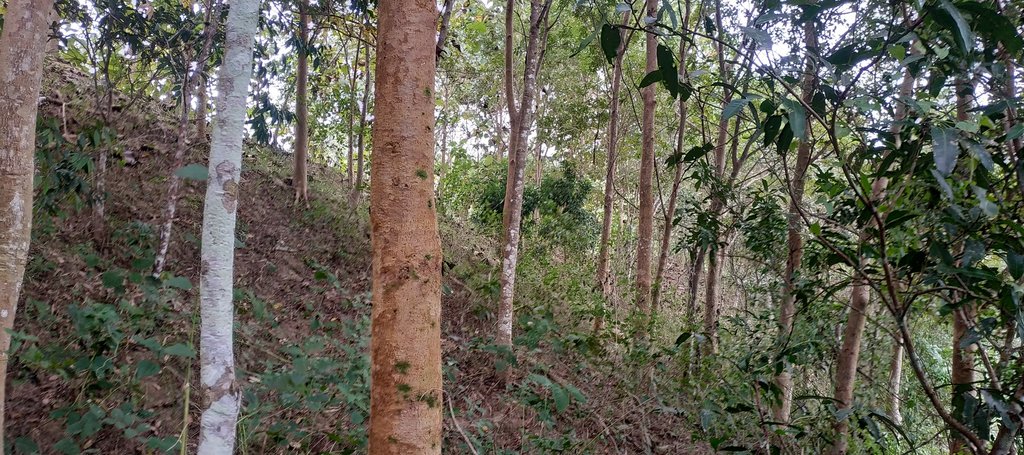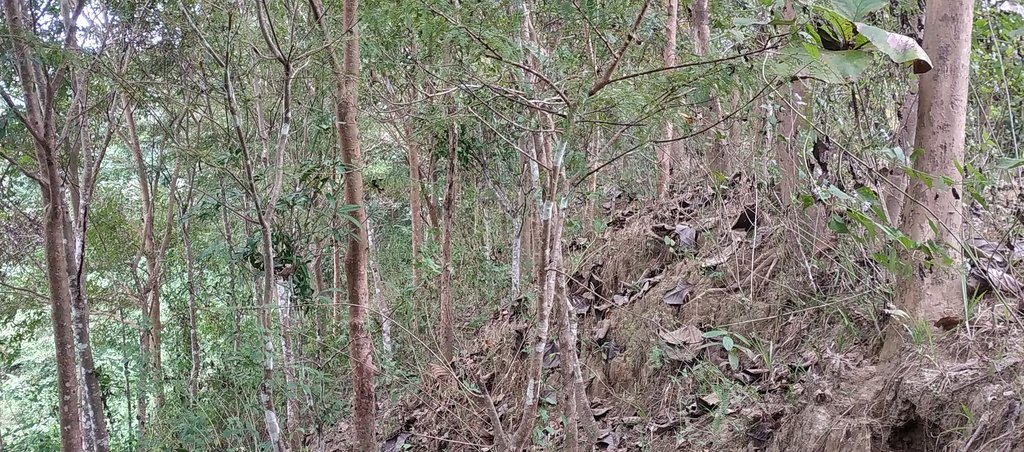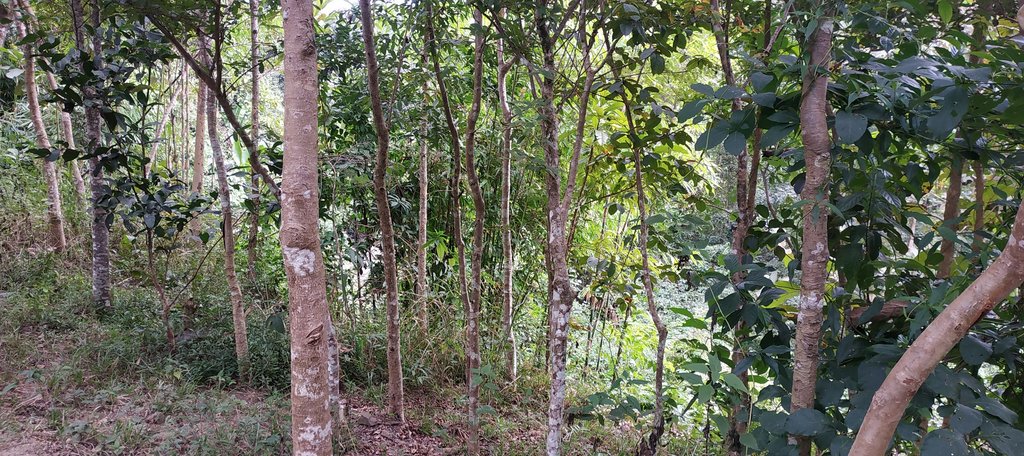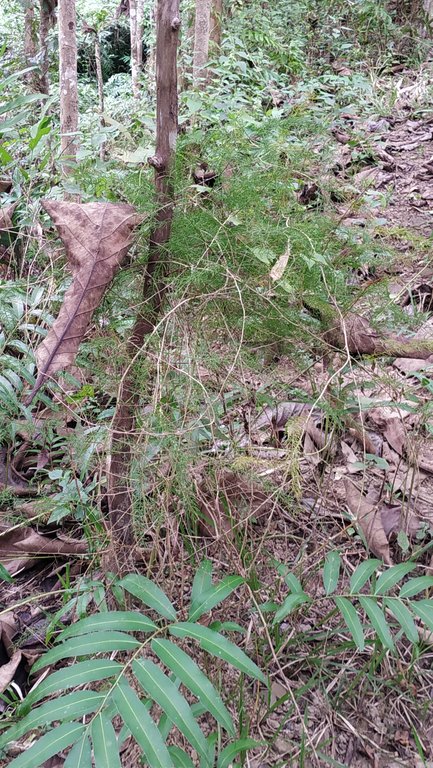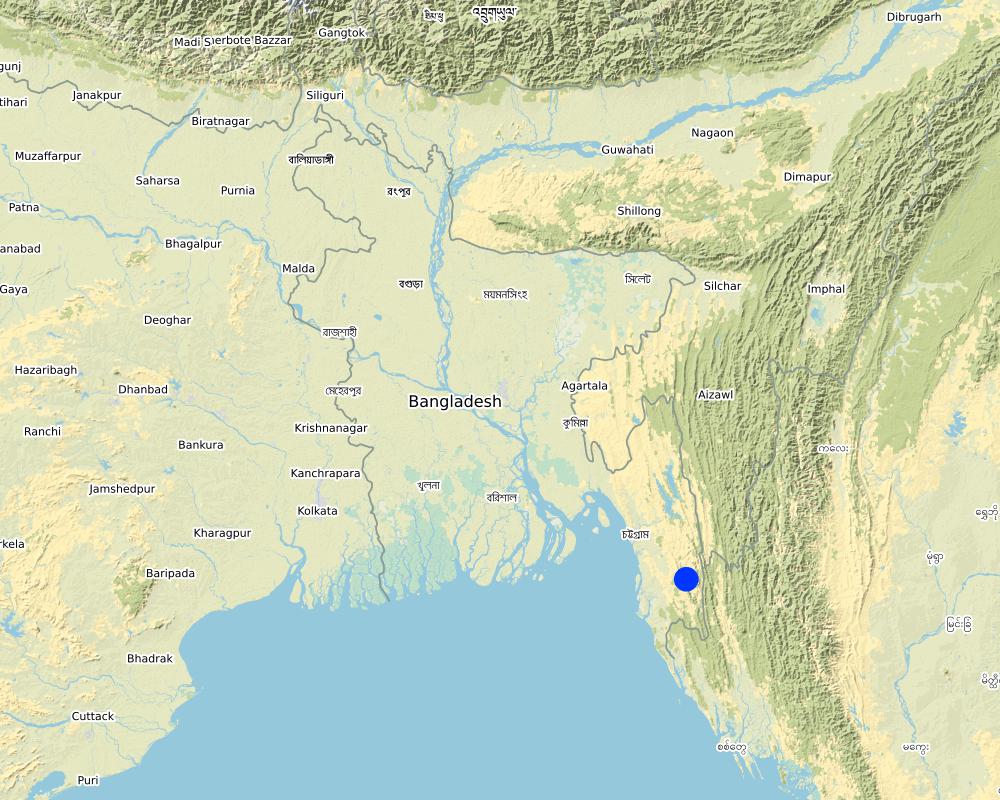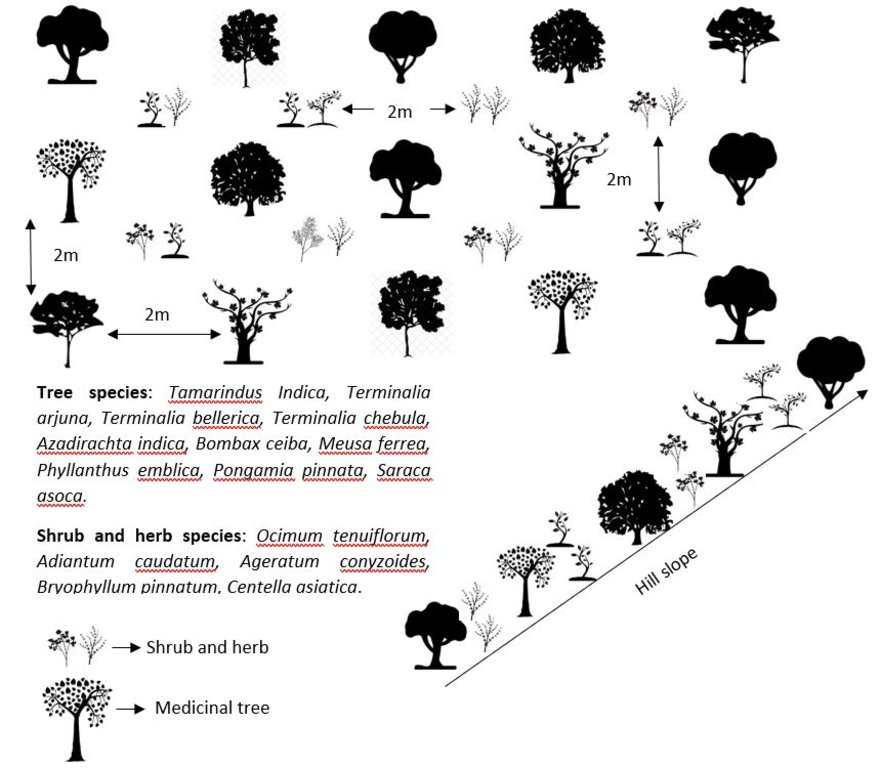Protection from land degradation through conservation of medicinal plants by involving ethnic communities. [Bangladesh]
- Création :
- Mise à jour :
- Compilateur : Fazlay Arafat
- Rédacteurs : Mutasim Billah, Md. Arfanuzzaman
- Examinateurs : Nicole Harari, Rima Mekdaschi Studer, Ursula Gaemperli
Herbal medicine plantation to stop land degradation
technologies_4287 - Bangladesh
Voir les sections
Développer tout Réduire tout1. Informations générales
1.2 Coordonnées des personnes-ressources et des institutions impliquées dans l'évaluation et la documentation de la Technologie
Personne(s)-ressource(s) clé(s)
exploitant des terres:
Thoai Uba
Bolipara Nari Kalyan Somity (BNKS)
Bangladesh
exploitant des terres:
Shing Nue Hla
Bolipara Nari Kalyan Somity (BNKS)
Bangladesh
Nom du projet qui a facilité la documentation/ l'évaluation de la Technologie (si pertinent)
Decision Support for Mainstreaming and Scaling out Sustainable Land Management (GEF-FAO / DS-SLM)Nom du ou des institutions qui ont facilité la documentation/ l'évaluation de la Technologie (si pertinent)
FAO Bangladesh (FAO Bangladesh) - BangladeshNom du ou des institutions qui ont facilité la documentation/ l'évaluation de la Technologie (si pertinent)
IUCN-The World Conservation Union (IUCN-The World Conservation Union) - Bangladesh1.3 Conditions relatives à l'utilisation par WOCAT des données documentées
Le compilateur et la(les) personne(s) ressource(s) acceptent les conditions relatives à l'utilisation par WOCAT des données documentées:
Oui
1.4 Déclaration sur la durabilité de la Technologie décrite
Est-ce que la Technologie décrite ici pose problème par rapport à la dégradation des terres, de telle sorte qu'elle ne peut pas être déclarée comme étant une technologie de gestion durable des terres?
Non
2. Description de la Technologie de GDT
2.1 Courte description de la Technologie
Définition de la Technologie:
The indigenous community in Bolipara village of the Thanchi upazlia (sub-district) of the Bandarban district are reducing or preventing land degradation through the cultivation and conservation of medicinal plants. This practice provides the raw material needed, by local traditional healers, to produce herbal medicines for the indigenous and tribal peoples.
2.2 Description détaillée de la Technologie
Description:
The Chittagong Hill Tracts (CHT) are well-renowned for its unique physiography that harbors rich biodiversity, and for its distinct and rich culture, traditional, and customary practices because of the predominance of many indigenous communities. It is also one of the few remaining areas in Bangladesh where traditional environmental knowledge (TEK) plays an important part in the daily life and customary practices of indigenous communities. Medicinal plants, of course, are a key component of the local health care system. However, the production and use of traditional medicines (mostly herbal in nature) substantively declined as medicinal plants have become rarer – this is due to rapid changes in land use patterns driven by population growth and economic trends. The risk that interest in and local knowledge of medicinal plant use will reduce or even disappear over time as has occurred in other parts of the world, changing the very nature of indigenous life. Land degradation is another major ecological concern for this area. Shifting cultivation with curtailed fallow periods, deforestation, and unplanned cultivation along the hill slopes has caused land degradation in Bolipara union. It is located in Thanchi upazila (longitude 21º78´, latitude 92º42´) under Bandarban hill district of Bangladesh. The total population of the union is more than 10,000. The ethnic communities living in the area include Bowm, Chakma, Khumi, Marma, Mru, Tripura and Chack. Most of the family depends on agriculture and horticulture for their livelihood. BNKS (Bolipara Nari Kalyan Somity) is an NGO who work here to promote the socio-economic and cultural status of the marginalized and socially excluded peoples. ‘Bolipara Kobiraj Kalyan Somiti’ is another local institution of traditional herbal healers.
In 2008, International Union for Conservation of Nature (IUCN) took the initiative to reduce and prevent land degradation in Bolipara through the cultivation and conservation of medicinal plants by indigenous communities. While forest conversion reduces the diversity and availability of medicinal plants, reforestation with medicinal plants can promote and accelerate forest succession on a previously deforested site. As a part of the IUCN project, medicinal tree species like Tamarindus indica, Terminalia arjuna, Terminalia bellerica, Terminalia chebula, Azadirachta indica, Bombax ceiba, Meusa ferrea, Phyllanthus emblica, Pongamia pinnata, and Saraca asoca were planted on the degraded slopes with a 2m x 2m spacing. In between the tree lines, shrub and herb species like Ocimum tenuiflorum, Adiantum caudatum, Ageratum conyzoides, Bryophyllum pinnatum, and Centella asiatica were planted with same spacing in a crisscross manner. The establishment of medicinal plants requires various inputs and extension services from medicinal plant nurseries to demonstration sites and the engagement of communities and community groups (please see more details under the download link: https://portals.iucn.org/library/node/9589).
In this instance, the planting and conservation of medicinal plants was conducted under the supervision of Buddhist monks (from local temples) and ‘Bolipara Kobiraj Kalyan Somiti’(BNKS). The local community were involved with Nursery preparation (seed collection, bed preparation, poly-bag preparation, manuring, irrigation, etc.), preparation of plantation site (jungle cutting, debris collection, preparation of inspection paths, etc.), plantation activities (pit preparation, tying up of plants with sticks for support, application of fertilizers, compost and biocide, etc.) and maintenance activities (vacancy filing, weeding, fertilizer application, etc.). After the medicinal plantation was established in 2008, the degraded land started to regain its health since trees and plants positively influenced the understory microclimate, the structural complexity of vegetation, and the development of humus layer. The indigenous medicinal plants and trees, because of their deep roots, also reduced topsoil erosion, and prevented gully erosion formation. Currently, the site is observed to have good canopy cover, and functions as a good habitat for a number of bird species and monkeys. The local herbal healers have the access to the plantation site and are able to obtain the raw materials needed to produce their medicines in short periods of time and with less effort. The local community people can collect dry leaves and dead branches from the plantation for firewood. This technology is simple enough to implement by the local people without any need of external financial and technical support. The local herbal healers have to collect raw materials to prepare their medicines.
Medicinal plants are an important component of Bangladesh’s national wealth. Even as they serve as important therapeutic agents in various traditional and modern medicines, our understanding of their abundance, distribution, and novel pharmaceutical compounds is poor. The planting/cultivation and conservation of medicinal plants and adequate engagement of local indigenous communities of Bolipara village is a good example of an action that can promote sustainability in all its dimensions (reduced land degradation, social and economic well-being through increase in raw material availability for traditional healers, etc.). Lack of marketing channel of medicinal raw materials and lack of scientific knowledge and tools for medicinal raw materials handling is a potential threat for sustaining the technology in the long run. The capacities of the local herbal healers can be strengthened through training and the marketing channel can be improved through engaging private sector in traditional medicine value chain.
2.3 Photos de la Technologie
2.5 Pays/ région/ lieux où la Technologie a été appliquée et qui sont couverts par cette évaluation
Pays:
Bangladesh
Région/ Etat/ Province:
Bandarban
Autres spécifications du lieu:
Bolipara village, Thanchi
Spécifiez la diffusion de la Technologie:
- répartie uniformément sur une zone
S'il n'existe pas d'informations exactes sur la superficie, indiquez les limites approximatives de la zone couverte:
- < 0,1 km2 (10 ha)
Est-ce que les sites dans lesquels la Technologie est appliquée sont situés dans des zones protégées en permanence?
Non
Map
×2.6 Date de mise en œuvre de la Technologie
Indiquez l'année de mise en œuvre:
2008
2.7 Introduction de la Technologie
Spécifiez comment la Technologie a été introduite: :
- par le biais de projets/ d'interventions extérieures
Commentaires (type de projet, etc.) :
"Conservation Through Practices" project implemented by IUCN Bangladesh and BNKS. The main objective of the project was to conserve medicinal plants in degraded land areas by the supervision of Monks in Buddhist temples.
3. Classification de la Technologie de GDT
3.1 Principal(aux) objectif(s) de la Technologie
- améliorer la production
- réduire, prévenir, restaurer les terres dégradées
- conserver/ améliorer la biodiversité
- créer un impact économique positif
- créer un impact social positif
3.2 Type(s) actuel(s) d'utilisation des terres, là où la Technologie est appliquée
Les divers types d'utilisation des terres au sein du même unité de terrain: :
Non

Forêts/ bois
- Plantations d'arbres, boisements
Plantation d'arbres, afforestation: Précisez l'origine et la composition des espèces. :
- Variétés mixtes
Type de plantation d'arbres, d'afforestation:
- plantations de forêts humides subtropicales - forêts de feuillus
- Tamarindus Indica, Terminalia arjuna, Terminalia bellerica, Terminalia chebula, Azadirachta indica, Bombax ceiba, Meusa ferrea, Phyllanthus emblica, Pongamia pinnata, Saraca asoca, Ocimum tenuiflorum, Adiantum caudatum, Ageratum conyzoides, Bryophyllum pinnatum, Centella asiatica.
Est-ce que les espèces d’arbres précisées ci-dessus sont des espèces d'arbre arbres à feuilles caduques ou à feuilles persistantes ?
- forêts à feuillage persistant
Produits et services:
- Bois d'œuvre (de construction)
- Bois de chauffage
- Fruits et noix
- Autres produits forestiers
- Conservation/ protection de la nature
- Loisirs/ tourisme
- Herbal Medicine
3.3 Est-ce que l’utilisation des terres a changé en raison de la mise en œuvre de la Technologie ?
Est-ce que l’utilisation des terres a changé en raison de la mise en œuvre de la Technologie ?
- Oui (Veuillez remplir les questions ci-après au regard de l’utilisation des terres avant la mise en œuvre de la Technologie)
Les divers types d'utilisation des terres au sein du même unité de terrain: :
Non

Terres improductives
Précisez:
The hill slope remains barren other than covered by some natural herbs and shrubs.
Remarques:
Soil erosion and land slide was a common phenomena in that area.
3.4 Approvisionnement en eau
Approvisionnement en eau des terres sur lesquelles est appliquée la Technologie:
- mixte: pluvial-irrigué
3.5 Groupe de GDT auquel appartient la Technologie
- gestion des plantations forestières
- Amélioration de la couverture végétale/ du sol
- amélioration des variétés végétales, des races animales
3.6 Mesures de GDT constituant la Technologie

pratiques végétales
- V1: Couverture d’arbres et d’arbustes
3.7 Principaux types de dégradation des terres traités par la Technologie

érosion hydrique des sols
- Wt: perte de la couche superficielle des sols (couche arable)/ érosion de surface
- Wm: mouvements de masse/ glissements de terrain

dégradation biologique
- Bc: réduction de la couverture végétale
- Bs: baisse de la qualité et de la composition/ diversité des espèces
3.8 Prévention, réduction de la dégradation ou réhabilitation des terres dégradées
Spécifiez l'objectif de la Technologie au regard de la dégradation des terres:
- réduire la dégradation des terres
4. Spécifications techniques, activités, intrants et coûts de mise en œuvre
4.1 Dessin technique de la Technologie
Spécifications techniques (associées au dessin technique):
Dimension of plantation: across the slope;
Spacing between Tree species: 2m X 2m;
Spacing between Shrub and herb species: 2m X 2m;
shrub and herb species planted in between tree lines with crisscross manner
Auteur:
Md. Fazlay Arafat
Date:
21/04/2019
4.2 Informations générales sur le calcul des intrants et des coûts
Spécifiez la manière dont les coûts et les intrants ont été calculés:
- par superficie de la Technologie
Indiquez la taille et l'unité de surface:
1 hectare
Si vous utilisez une unité de superficie locale, indiquez le facteur de conversion vers un hectare (p.ex. 1 ha = 2.47 acres): 1 ha = :
2.47 acres
autre/ monnaie nationale (précisez):
BDT
Indiquez le taux de change des USD en devise locale, le cas échéant (p.ex. 1 USD = 79.9 réal brésilien): 1 USD = :
83,0
Indiquez le coût salarial moyen de la main d'œuvre par jour:
BDT 500
4.3 Activités de mise en place/ d'établissement
| Activité | Calendrier des activités (saisonnier) | |
|---|---|---|
| 1. | Nursery preparation (seed collection, site clearing, leveling and fencing, drainage arrangement, bed preparation, making overhead shed, poly-bag preparation, potting seeds, manuring, irrigation, weed control) | September-October |
| 2. | Site preparation (boundary demarcation, jungle cutting, debris collection and staging, preparation of inspection paths and fire lines) | May-June |
| 3. | Plantation (pit preparation, tying up of plants, application of fertilizers, compost and biocide, stick for support) | June-July |
4.4 Coûts et intrants nécessaires à la mise en place
| Spécifiez les intrants | Unité | Quantité | Coûts par unité | Coût total par intrant | % des coût supporté par les exploitants des terres | |
|---|---|---|---|---|---|---|
| Main d'œuvre | Nursery preparation (seed collection, site clearing, leveling and fencing, drainage arrangement, bed preparation, making overhead shed, poly-bag preparation, potting seeds, manuring, irrigation, weed control) | person-days | 25,0 | 500,0 | 12500,0 | 100,0 |
| Main d'œuvre | Plantation site preparation (boundary demarcation, jungle cutting, debris collection and staging, preparation of inspection paths and fire lines) | person-days | 13,0 | 500,0 | 6500,0 | 100,0 |
| Main d'œuvre | Plantation (pit preparation, tying up of plants, application of fertilizers, compost and biocide, stick for support) | person-days | 27,0 | 500,0 | 13500,0 | 100,0 |
| Equipements | Poly-bags | pieces | 3000,0 | 1,0 | 3000,0 | |
| Equipements | Bamboo for shed and bed edging | pieces | 6,0 | 250,0 | 1500,0 | |
| Equipements | Nursery equipment (Bucket, spade, scissor, knife etc.) | Lump sum | 1,0 | 600,0 | 600,0 | |
| Matériel végétal | Procure and transport of loamy soil for filling 3000 poly-bags (17.78cmX1270cm ) | Cubic Meter | 3,0 | 400,0 | 1200,0 | |
| Matériel végétal | Seed purchase | Kg | 3,0 | 500,0 | 1500,0 | |
| Matériel végétal | Bamboo stick for tying up of plants | pieces | 2600,0 | 2,0 | 5200,0 | |
| Engrais et biocides | Compost | Kg | 700,0 | 4,0 | 2800,0 | |
| Engrais et biocides | Urea | Kg | 15,0 | 35,0 | 525,0 | |
| Engrais et biocides | TSP | Kg | 15,0 | 40,0 | 600,0 | |
| Engrais et biocides | MOP | Kg | 15,0 | 30,0 | 450,0 | |
| Engrais et biocides | Biocide | Lump Sum | 1,0 | 200,0 | 200,0 | |
| Matériaux de construction | Signboard (for demarcation of plantation site) | Lump Sum | 1,0 | 1000,0 | 1000,0 | 100,0 |
| Coût total de mise en place de la Technologie | 51075,0 | |||||
| Coût total de mise en place de la Technologie en dollars américains (USD) | 615,36 | |||||
Commentaires:
Traditional local healers and Buddhist monks of Bolipara are the land user here. The project of IUCN Bangladesh titled as, ‘One Stop Service: facilitating conservation of medicinal plant and traditional health service to ethnic communities of Chittagong Hill Tracts (CHT) Bangladesh’ covered some cost of the technology.
4.5 Activités d'entretien/ récurrentes
| Activité | Calendrier/ fréquence | |
|---|---|---|
| 1. | Vacancy filing | June-July |
| 2. | Tying up of plants | June-July |
| 3. | Fertilizer application | June-July |
| 4. | Weeding | Three times in a year |
4.6 Coûts et intrants nécessaires aux activités d'entretien/ récurrentes (par an)
| Spécifiez les intrants | Unité | Quantité | Coûts par unité | Coût total par intrant | % des coût supporté par les exploitants des terres | |
|---|---|---|---|---|---|---|
| Main d'œuvre | Vacancy filling | Person-days | 6,0 | 500,0 | 3000,0 | 100,0 |
| Main d'œuvre | Tying up of plants | Person-days | 1,0 | 500,0 | 500,0 | 100,0 |
| Main d'œuvre | Fertilizer application | Person-days | 5,0 | 500,0 | 2500,0 | 100,0 |
| Main d'œuvre | Weeding (3 times) | Person-days | 18,0 | 500,0 | 9000,0 | 100,0 |
| Matériel végétal | Bamboo stick for tying up of plants | pieces | 550,0 | 2,0 | 1100,0 | |
| Matériel végétal | Seedling | pieces | 500,0 | 5,0 | 2500,0 | 100,0 |
| Engrais et biocides | NPK fertilizer | Kg | 125,0 | 30,0 | 3750,0 | |
| Coût total d'entretien de la Technologie | 22350,0 | |||||
| Coût total d'entretien de la Technologie en dollars américains (USD) | 269,28 | |||||
Si le coût n'est pas pris en charge à 100% par l'exploitant des terres, indiquez qui a financé le coût restant:
The project "One Stop Service: facilitating conservation of medicinal plant and traditional health service to ethnic communities of Chittagong Hill Tracts (CHT) Bangladesh" covered some maintenance cost of the plantation.
4.7 Facteurs les plus importants affectant les coûts
Décrivez les facteurs les plus importants affectant les coûts :
Labor cost
5. Environnement naturel et humain
5.1 Climat
Précipitations annuelles
- < 250 mm
- 251-500 mm
- 501-750 mm
- 751-1000 mm
- 1001-1500 mm
- 1501-2000 mm
- 2001-3000 mm
- 3001-4000 mm
- > 4000 mm
Spécifiez la pluviométrie moyenne annuelle (si connue), en mm:
2528,00
Zone agro-climatique
- subhumide
Mean annual temperature is 25.9 °C
5.2 Topographie
Pentes moyennes:
- plat (0-2 %)
- faible (3-5%)
- modéré (6-10%)
- onduleux (11-15%)
- vallonné (16-30%)
- raide (31-60%)
- très raide (>60%)
Reliefs:
- plateaux/ plaines
- crêtes
- flancs/ pentes de montagne
- flancs/ pentes de colline
- piémonts/ glacis (bas de pente)
- fonds de vallée/bas-fonds
Zones altitudinales:
- 0-100 m
- 101-500 m
- 501-1000 m
- 1001-1500 m
- 1501-2000 m
- 2001-2500 m
- 2501-3000 m
- 3001-4000 m
- > 4000 m
Indiquez si la Technologie est spécifiquement appliquée dans des:
- situations convexes
5.3 Sols
Profondeur moyenne du sol:
- très superficiel (0-20 cm)
- superficiel (21-50 cm)
- modérément profond (51-80 cm)
- profond (81-120 cm)
- très profond (>120 cm)
Texture du sol (de la couche arable):
- moyen (limoneux)
Texture du sol (> 20 cm sous la surface):
- moyen (limoneux)
Matière organique de la couche arable:
- moyen (1-3%)
5.4 Disponibilité et qualité de l'eau
Profondeur estimée de l’eau dans le sol:
> 50 m
Disponibilité de l’eau de surface:
moyenne
Qualité de l’eau (non traitée):
faiblement potable (traitement nécessaire)
La qualité de l'eau fait référence à:
eaux de surface
La salinité de l'eau est-elle un problème? :
Non
La zone est-elle inondée?
Non
5.5 Biodiversité
Diversité des espèces:
- élevé
Diversité des habitats:
- moyenne
5.6 Caractéristiques des exploitants des terres appliquant la Technologie
Sédentaire ou nomade:
- Sédentaire
Orientation du système de production:
- subsistance (auto-approvisionnement)
Revenus hors exploitation:
- moins de 10% de tous les revenus
Niveau relatif de richesse:
- très pauvre
Individus ou groupes:
- groupe/ communauté
Niveau de mécanisation:
- travail manuel
Genre:
- femmes
- hommes
Age des exploitants des terres:
- jeunes
- personnes d'âge moyen
- personnes âgées
5.7 Superficie moyenne des terres utilisées par les exploitants des terres appliquant la Technologie
- < 0,5 ha
- 0,5-1 ha
- 1-2 ha
- 2-5 ha
- 5-15 ha
- 15-50 ha
- 50-100 ha
- 100-500 ha
- 500-1 000 ha
- 1 000-10 000 ha
- > 10 000 ha
Cette superficie est-elle considérée comme de petite, moyenne ou grande dimension (en se référant au contexte local)?
- petite dimension
5.8 Propriété foncière, droits d’utilisation des terres et de l'eau
Propriété foncière:
- communauté/ village
Droits d’utilisation des terres:
- communautaire (organisé)
Droits d’utilisation de l’eau:
- accès libre (non organisé)
Est-ce que les droits d'utilisation des terres sont fondés sur un système juridique traditionnel?
Non
Précisez:
The private land was donated to the Bolipara Kobiraj Kalyan Somiti by its original owner. The Bolipara Kobiraj Kalyan Somiti is a local institution of traditional healers and Buddhist monk.
5.9 Accès aux services et aux infrastructures
santé:
- pauvre
- modéré
- bonne
éducation:
- pauvre
- modéré
- bonne
assistance technique:
- pauvre
- modéré
- bonne
emploi (par ex. hors exploitation):
- pauvre
- modéré
- bonne
marchés:
- pauvre
- modéré
- bonne
énergie:
- pauvre
- modéré
- bonne
routes et transports:
- pauvre
- modéré
- bonne
eau potable et assainissement:
- pauvre
- modéré
- bonne
services financiers:
- pauvre
- modéré
- bonne
6. Impacts et conclusions
6.1 Impacts sur site que la Technologie a montrés
Impacts socio-économiques
Production
qualité des forêts/ bois
production forestière non ligneuse
risque d'échec de la production
diversité des produits
surface de production
Revenus et coûts
revenus agricoles
Commentaires/ spécifiez:
local traditional healers and their family profit from the medical plants
diversité des sources de revenus
Impacts socioculturels
situation sanitaire
opportunités culturelles
Commentaires/ spécifiez:
Local healers now able to extract various medicinal plants and display herbal medicines in local herbal fair
institutions communautaires
Commentaires/ spécifiez:
The community institution "Bolipara Kobiraj Kalyan Somiti" has been strengthened through their improved cooperation and availability of raw materials for medicines.
connaissances sur la GDT/ dégradation des terres
Commentaires/ spécifiez:
The local community learned how to improve a degraded site with tree plantation.
situation des groupes socialement et économiquement désavantagés
Commentaires/ spécifiez:
The situation of local traditional healers improved as they now manage source of raw materials by themselves for their medicines
Impacts écologiques
Cycle de l'eau/ ruissellement
ruissellement de surface
drainage de l'excès d'eau
nappes phréatiques/ aquifères
Sols
humidité du sol
couverture du sol
perte en sol
cycle/ recharge des éléments nutritifs
matière organique du sol/ au dessous du sol C
Biodiversité: végétale, animale
Couverture végétale
biomasse/ au dessus du sol C
diversité végétale
espèces étrangères envahissantes
diversité animale
espèces bénéfiques
diversité des habitats
contrôle des animaux nuisibles/ maladies
Réduction des risques de catastrophe et des risques climatiques
glissements de terrains/coulées de débris
émissions de carbone et de gaz à effet de serre
risques d'incendies
Commentaires/ spécifiez:
The plantation reduces the risk of incendiary fire for shifting cultivation
vitesse du vent
microclimat
6.2 Impacts hors site que la Technologie a montrés
flux des cours d'eau fiables et stables en saison sèche
Commentaires/ spécifiez:
The canopy cover of the plantation site improves the watershed management and increased the stable streams flows in dry season
impact des gaz à effet de serre
6.3 Exposition et sensibilité de la Technologie aux changements progressifs et aux évènements extrêmes/catastrophes liés au climat (telles que perçues par les exploitants des terres)
Changements climatiques progressifs
Changements climatiques progressifs
| Saison | Augmentation ou diminution | Comment la Technologie fait-elle face à cela? | |
|---|---|---|---|
| températures annuelles | augmente | pas connu | |
| températures saisonnières | saison sèche | augmente | modérément |
| précipitations annuelles | décroît | pas connu | |
| précipitations saisonnières | saison des pluies/ humide | augmente | bien |
Extrêmes climatiques (catastrophes)
Catastrophes hydrologiques
| Comment la Technologie fait-elle face à cela? | |
|---|---|
| glissement de terrain | bien |
6.4 Analyse coûts-bénéfices
Quels sont les bénéfices comparativement aux coûts de mise en place (du point de vue des exploitants des terres)?
Rentabilité à court terme:
légèrement négative
Rentabilité à long terme:
très positive
Quels sont les bénéfices comparativement aux coûts d'entretien récurrents (du point de vue des exploitants des terres)?
Rentabilité à court terme:
légèrement négative
Rentabilité à long terme:
très positive
6.5 Adoption de la Technologie
- 1-10%
De tous ceux qui ont adopté la Technologie, combien d'entre eux l'ont fait spontanément, à savoir sans recevoir aucune incitation matérielle, ou aucune rémunération? :
- 0-10%
6.6 Adaptation
La Technologie a-t-elle été récemment modifiée pour s'adapter à l'évolution des conditions?
Non
6.7 Points forts/ avantages/ possibilités de la Technologie
| Points forts/ avantages/ possibilités du point de vue de l'exploitant des terres |
|---|
| Reduction in land degradation. |
| Enhancement of the supply of medicinal raw materials. |
| Conservation of rare and endangered medicinal plant species. |
| Points forts/ avantages/ possibilités du point de vue du compilateur ou d'une autre personne ressource clé |
|---|
| Builds community awareness of biodiversity conservation |
| Increase of carbon sequestration |
6.8 Faiblesses/ inconvénients/ risques de la Technologie et moyens de les surmonter
| Faiblesses/ inconvénients/ risques du point de vue de l’exploitant des terres | Comment peuvent-ils être surmontés? |
|---|---|
| Land use conflicts for short term income. The tree species require significant time to grow and yield fruits and flowers for herbal use. Short term return from the plantation site is low compared to other land uses e.g. shifting cultivation, annual crop cultivation, etc. | There is a need to diversify income sources for the communities |
| Adjacent commercial teak plantation is a threat to soil erosion. | Requires engagement of the teak plantation owners and increasing knowledge of local community |
| Lack of capacities for medicinal raw materials storage. | Could potentially involve private organizations in the medicinal value chain |
| Faiblesses/ inconvénients/ risques du point de vue du compilateur ou d'une autre personne ressource clé | Comment peuvent-ils être surmontés? |
|---|---|
| Lack of training and tools for proper use of medicinal raw materials. | Strengthen the capacities of local healers through training |
| Lack of marketing channel to distribute herbal medicines in other places. | Opportunity to involve the private sector in traditional medicine value chain |
7. Références et liens
7.1 Méthodes/ sources d'information
- visites de terrain, enquêtes sur le terrain
Number of informants: 04
- interviews/entretiens avec les exploitants des terres
Number of informants: 03
- compilation à partir de rapports et d'autres documents existants
Number of informants: 02
Quand les données ont-elles été compilées (sur le terrain)?
17/12/2018
7.2 Références des publications disponibles
Titre, auteur, année, ISBN:
Motaleb, M.A. et al. 2011. Selected Medicinal Plants of Chittagong Hill Tracts. ISBN: 978-984-33-3650-7
Disponible à partir d'où? Coût?
IUCN Bangladesh
Titre, auteur, année, ISBN:
Motaleb, M. A., 2010. Approaches to Conservation of Medicinal Plants and Traditional Knowledge: A Focus on the Chittagong Hill Tracts. IUCN (International Union for Conservation of Nature), Bangladesh Country Office, Dhaka, Bangladesh, pp viii+30.
Disponible à partir d'où? Coût?
https://portals.iucn.org/library/sites/library/files/documents/2010-030.pdf
7.3 Liens vers les informations pertinentes en ligne
Titre/ description:
Medicinal Plant Abundance in Degraded and Reforested Sites in Northwest Pakistan
URL:
URL: https://doi.org/10.1659/MRD-JOURNAL-D-09-00017.1
7.4 Observations d'ordre général
The WOCAT questionnaire covers all the technical aspects of this technology
Liens et modules
Développer tout Réduire toutLiens
Aucun lien
Modules
Aucun module trouvé


